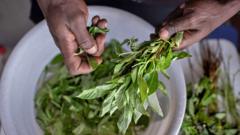In Kenya, a surprising culinary trend is emerging as once-dismissed indigenous leafy vegetables are experiencing a renaissance. Dubbed "kienyeji", these traditional greens such as managu (African nightshade) and mrenda (jute mallow) are rapidly appearing on restaurant menus and in markets, highlighting their newfound popularity.
At Skinners Restaurant in Gachie, near Nairobi, the demand for kienyeji outstrips that for conventional greens like cabbage and spinach. As Kimani Ng'ang'a, a restaurant employee, noted, patrons are willing to pay more for these organic, locally sourced vegetables. Nutrition enthusiasts in Kenya are turning to these native varieties for health benefits, including higher vitamin and mineral content compared to introduced species. Research shows these greens help detoxify the body and support weight loss.
Professor Mary Abukutsa-Onyango, a horticulture expert, supports this shift with data indicating that indigenous vegetable production has doubled, reaching 300,000 tonnes last year. Once seen as inferior crops, these greens are recognized for their resilience and organic growing potential, contributing positively to food security.
Despite hurdles, such as strict laws against seed exchange, farmers like Francis Ngiri are determined to safeguard these traditional varieties. His organic farm in the Rift Valley has grown to feature 124 indigenous crops, and he collaborates with others to ensure genetic diversity.
As awareness grows, new regulations may soon emerge to align Kenya’s agricultural laws with international treaties that support farmers' rights to save and share seeds. Vendors like Priscilla Njeri report that the appetite for indigenous greens is stronger than ever, showing a clear shift in consumer preferences toward these nutritious options.



















